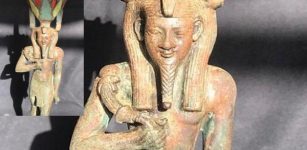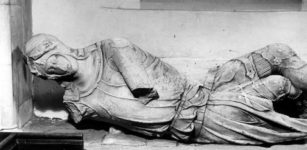Chalchihuitlicue: Beautiful, Dangerous, Changeable And Unpredictable Water Goddess In Aztec Mythology
A. Sutherland - AncientPages.com - From the beginning of human history, water has held a significant role in people's belief systems. Long ago, they realized that they couldn't live without it.
Chalchiuhtlicue Aztec Goddess Of Water (Musée du quai Branly). Image credit: Sailko - CC BY-SA 3.0 DEED
They also recognized the profound influence of water on nature as a whole. Even our ancestors acknowledged water as one of the four fundamental elements, which, together with earth, fire, and air, constituted their understanding of the world's order. Water was personified in almost every culture and was worshiped as a powerful deity. People turned to their powerful deities during times of both scarcity and abundance of water, during droughts and floods alike.
Like in many cultures worldwide, also the inhabitants of what we today call Mesoamerica, worshiped the deities closely associated with water. These divine figures had once a most important position in the pantheon of gods.
Chalchihuitlicue, who represented the advanced civilization of the city of Teotihuacan, was a young goddess. Beautiful and dangerous, changeable and at the same time unpredictable, Chalchihuitlicue had water as her predominant element. She watered the earth, promoting fertility, and flooded it, causing destruction and death of people and animals.
Legends usually vary; in one of them, Chalchuihtilcue is the wife of Tlaloc, but in another she is his sister. Among some other scholars, Chalchuihtilcue is the god Tlaloc himself in disguise. Anyway, she is the one who governs over rivers, lakes, horizontal waters, and streams. Translated as ‘She of the Jade Skirt’, the goddess’ name came from the word ‘Chalchuitl’ (in Nahuatl language: jade). Her name was, therefore, a metaphorical allusion to the blue-green waters of the tropical ocean, shining like the colors in the precious stone.
Perhaps because of its association with water, jade was the most valued rock in Mesoamerica.
Illustration of Chalchiuhtlicue, one of the deities described in the Codex Borgia. Image credit: Unknown - Public Domain
Chalchiutlicue was often held responsible for floods and storms on the seas. Additionally, her female aspect linked her with the watery nature of the womb, and therefore, she played a vital role in the birth and traditional baptismal ceremonies.
The Aztecs (like other agricultural societies) depended heavily on water for their and land’s survival, so the Aztecs always asked Chalchiutlicue for a good harvest of crops.
She was highly revered in the Aztec culture at the time of the Spanish conquest, and she was an important deity figure in the Postclassic Aztec realm of central Mexico in the post-classic period from 1300 to 1521.
Interestingly, some still believe that the presence of this powerful goddess still persists in modern Mexican folklore. Did Chalchiutlicue’s association with Chalchiuhtlatonal, another Aztec water god, also survive to modern times?
His area of special protection included the sea and the animals living in it.
Drawing of (Mesoamerican deity) Chalchiutlicue from (17th century manuscript) Codex Ríos. Chalciutlicue is shown with implements of spinning and weaving. The figures swimming in the stream emanating in her dress could be read as offspring or as those being carried away toward death. Image credit: Unknown author – Public Domain
Ancient tradition has it that god Chalchiuhtlatonal grants one human the gift of water every 10,000 years to help look after the sea.
Chalchiutlicue is depicted in several central Mexican manuscripts, including the Pre-Columbian Codex Borgia, the 16th century Codex Borbonicus, the 16th century Codex Ríos, and the Florentine Codex.
In Aztec art, craftsmen usually carved her sculptures using green stone like jade or similar green stones with respect to her name.
In pre-Columbian and colonial codices, the goddess is described as wearing a bluish-green skirt, from which flows a long, abundant stream of water. Her skirt is like seawater additionally ornamented with water lilies.
National Museum of Anthropology in Mexico City. Aztec mask of Chalchuihtlicue, goddess of water. Image credit: Wolfgang Sauber - CC BY-SA 3.0
Her depictions also emphasize a green stone necklace hanging from her neck and a blue cap with beautiful quetzal feathers on the goddess’s head. Other accents of her outfit include turquoise-colored clappers and earplugs.
Chalchuihtilcue ( “She of the Skirt of Precious Stones”) was believed to be the goddess of running water and was also known as Matlalcueitl (Matlacueye) - “She of thee Blue Skirt”). This name she shares with the mountain peak, today known as “La Malinche”, an inactive volcano (dormant for the last 3,100 years), which is the sixth-highest in Mexico.
From the Aztec theogony we learn that the Third Age of the universe had been under the rule of Tlaloc, the rain god while the Fourth Age was governed by Chalchihuitlicue. The age of Tlaloc ended by fire coming from volcanoes in fiery eruption. Tradition says that the people who lived in those days were turned into butterflies and birds. The Fourth Age of Chalchihuitlicue ended in a terrible flood which turned humankind into fishes. Water, therefore, is seen here in its destructive aspect and may well be an instrument of death.
Written by – A. Sutherland - AncientPages.com Senior Staff Writer
Copyright © AncientPages.com All rights reserved. This material may not be published, broadcast, rewritten or redistributed in whole or part without the express written permission of AncientPages.com
Expand for referencesReferences:
A. Sutherland, "Aztecs’ Five Suns Creation Myth And Prophecy"
Hall Linda B., “Visions of the Feminine: The Dual Goddesses of Ancient Mexico.” Southwest Review 63, no. 2 (1978): 133–42.
Arnold, Philip P. “Paper Ties to Land: Indigenous and Colonial Material Orientations to the Valley of Mexico.” History of Religions 35, no. 1 (1995): 27–60.
Bošković, Aleksandar. “In the Age of the Fifth Sun: Jacques Soustelle’s Studies of Aztec Religion.” Anthropos 87, no. 4/6 (1992): 533–37.
More From Ancient Pages
-
 Queen Nefertari – Favorite Wife Of Ramses II The Great And Her Lavishly Decorated Tomb In The Valley Of The Queens
Featured Stories | May 22, 2020
Queen Nefertari – Favorite Wife Of Ramses II The Great And Her Lavishly Decorated Tomb In The Valley Of The Queens
Featured Stories | May 22, 2020 -
 Carved Statue Of God Nefertum Unearthed In Egypt’s Saqqara Necropolis
Archaeology | Oct 3, 2020
Carved Statue Of God Nefertum Unearthed In Egypt’s Saqqara Necropolis
Archaeology | Oct 3, 2020 -
 Unravelling The Mystery Of Apollonius Of Tyana – Was He A Superhuman?
Ancient Mysteries | Sep 17, 2015
Unravelling The Mystery Of Apollonius Of Tyana – Was He A Superhuman?
Ancient Mysteries | Sep 17, 2015 -
 Wilhelm Tell: Famous Legendary Crossbowman And Swiss Patriot – Symbol Of Freedom And Dignity
Featured Stories | Nov 2, 2016
Wilhelm Tell: Famous Legendary Crossbowman And Swiss Patriot – Symbol Of Freedom And Dignity
Featured Stories | Nov 2, 2016 -
 Mayong – Mysterious Ancient Land Of Black Magic In India
Featured Stories | Mar 7, 2019
Mayong – Mysterious Ancient Land Of Black Magic In India
Featured Stories | Mar 7, 2019 -
 Mystery Of Andreas Rill: Was He A Time Traveler, Holy Man Or An Unidentified Prophet In Disguise?
Featured Stories | Oct 25, 2018
Mystery Of Andreas Rill: Was He A Time Traveler, Holy Man Or An Unidentified Prophet In Disguise?
Featured Stories | Oct 25, 2018 -
 Native American Population Does Not Originate In Japan – Genetics And Skeletal Biology Questioned
Archaeology | Nov 15, 2021
Native American Population Does Not Originate In Japan – Genetics And Skeletal Biology Questioned
Archaeology | Nov 15, 2021 -
 Aldworth Giants: Knights Who People Tried To Erase From History
Featured Stories | Jul 2, 2015
Aldworth Giants: Knights Who People Tried To Erase From History
Featured Stories | Jul 2, 2015 -
 On This Day In History: Vasco De Gama Departed On First European Voyage To India – On July 8, 1497
News | Jul 8, 2016
On This Day In History: Vasco De Gama Departed On First European Voyage To India – On July 8, 1497
News | Jul 8, 2016 -
 LIDAR Discovers Two Remarkably Large Sites In The Amazon And Evidence Of Early Urbanism
Archaeology | May 25, 2022
LIDAR Discovers Two Remarkably Large Sites In The Amazon And Evidence Of Early Urbanism
Archaeology | May 25, 2022 -
 Mysterious Giant Rock Face Discovered On B.C’s Central Coast – Natural Or Man-Made Structure?
News | Mar 28, 2020
Mysterious Giant Rock Face Discovered On B.C’s Central Coast – Natural Or Man-Made Structure?
News | Mar 28, 2020 -
 Clurichaun – Little Naughty And Drunken Fellow Akin To Leprechaun In Irish Folklore
Featured Stories | Sep 13, 2019
Clurichaun – Little Naughty And Drunken Fellow Akin To Leprechaun In Irish Folklore
Featured Stories | Sep 13, 2019 -
 Three Fun Paradoxes Created By Ancient Greek Philosophers To Puzzle Over
Featured Stories | Aug 28, 2024
Three Fun Paradoxes Created By Ancient Greek Philosophers To Puzzle Over
Featured Stories | Aug 28, 2024 -
 Mystery Of Ancient Gaza Wine – New Insight
Archaeology | Apr 26, 2023
Mystery Of Ancient Gaza Wine – New Insight
Archaeology | Apr 26, 2023 -
 Unexplained Phenomena Witnessed Around Mysterious Ancient Stone Structures In New York – Can A Sacred Native American Mountain Offer Clues?
Featured Stories | Nov 3, 2024
Unexplained Phenomena Witnessed Around Mysterious Ancient Stone Structures In New York – Can A Sacred Native American Mountain Offer Clues?
Featured Stories | Nov 3, 2024 -
 Bronze Age Human Remains Uncovered In Dorset During Excavation Of Iron Age Settlement
Archaeology | Jul 10, 2023
Bronze Age Human Remains Uncovered In Dorset During Excavation Of Iron Age Settlement
Archaeology | Jul 10, 2023 -
 Huge Statue Of Pharaoh Ramesses II Unearthed In The Ancient City Of Hermopolis
Archaeology | Mar 4, 2024
Huge Statue Of Pharaoh Ramesses II Unearthed In The Ancient City Of Hermopolis
Archaeology | Mar 4, 2024 -
 On This Day In History: Western Roman Emperor Severus II Died – On Sep 16, 307
News | Sep 16, 2016
On This Day In History: Western Roman Emperor Severus II Died – On Sep 16, 307
News | Sep 16, 2016 -
 Bellerophon: Great Hero Of Homer’s Iliad Who Was Punished By Gods For His Pride And Arrogance
Featured Stories | Jul 13, 2021
Bellerophon: Great Hero Of Homer’s Iliad Who Was Punished By Gods For His Pride And Arrogance
Featured Stories | Jul 13, 2021 -
 Anundshög Burial Mound: One Of Sweden’s Richest And Largest Sacred Ancient Sites
Featured Stories | Aug 29, 2018
Anundshög Burial Mound: One Of Sweden’s Richest And Largest Sacred Ancient Sites
Featured Stories | Aug 29, 2018




